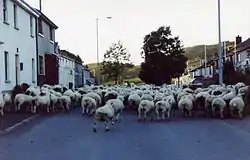Cappagh, County Tyrone
Cappagh (Irish: Ceapach (tilled or cultivated land)[1]) is a small village and townland in the parish of Pomeroy[2][3] in County Tyrone, Northern Ireland. It is between Pomeroy, Ballygawley, Galbally and Carrickmore, with the hamlet of Galbally about one mile to the east. Most of the land around Cappagh is farmland although a quarry lies just outside the village.
In County Tyrone, there is also the parish of Cappagh which includes part of the town of Omagh and small village of Mountfield. There is also a small rural parish in western Limerick with the same name.
Places of interest

- Cappagh Mountain - The village is located on a hillside and immediately behind it stands Cappagh Mountain (948 feet tall). The area around Cappagh has fine mountain scenery where the land is a mixture of rural pastures and bog. These bog and peat lands still provide turf for the older generation of the area.
- Travelling towards Altmore on the right hand side of the road is "King James's Well". Further on was once a small house that occupied some of the finest miniature model houses and castles in Northern Ireland.
- Cappagh Monument - In the middle of the village is a monument to local people who were killed by British security forces and paramilitaries during The Troubles. It features a stone figure of a Provisional IRA Volunteer, in front of a number of stone plaques commemorating various aspects of the conflict, such as the Hunger Strike of 1981 and local Republicans who died. The focal point is the plaque for eight Provisional IRA members who died during gun and bomb attack on Loughgall Royal Ulster Constabulary (RUC) base, and are referred as the "Loughgall Martyrs" by the Republican movement.[4]
The Troubles in Cappagh
At least 10 people in and around Cappagh lost their lives during the Troubles, according to CAIN website. Three were members of the Provisional IRA, three were members of the RUC, two Catholic civilians, one former member of the UDR, and a Protestant civilian. The three IRA Volunteers and one of the Catholic residents were killed by the Ulster Volunteer Force in a shooting outside a local bar on 3 March 1991. The British army had saturated the area in the week before the attack but had mysteriously withdrawn from the area the morning of the attack. A week before the attack heavily armed RUC came into the pub, ID'd locals and made a detailed plan of the building before they left. A civilian had been shot and killed in the same spot in January 1974 by loyalist assailants. The rest of the victims were killed by members of the Provisional IRA.[5]
The village, famed as being a Republican stronghold,[6] was also the scene of another two significant events in the early 1990s. On 24 March 1990, there was a gun battle between an IRA unit and undercover British security forces when a civilian-type vehicle driven by an undercover agent was fired on by IRA volunteers without warning, according to Archie Hamilton, then Minister of State for the Armed Forces.[7] Republican sources claimed a SAS ambush was thwarted and at least two undercover soldiers in the car were killed.[8]
Another major incident, at least for its consequences, involving British forces took place on 12 May 1992, when a patrol of the Third Battalion of the Parachute Regiment was ambushed with an anti-personnel device by the IRA in Cappagh. One soldier lost both legs. The attack sparked the reaction of the paratroopers, which sealed off the nearby town of Coalisland and clashed with the local population on 12 and 17 May 1992.[9] The RUC alleged that a light machine gun stolen during the second incident was later recovered at a farmhouse near Cappagh, as part of a weapons cache.[10] This series of incidents led to the suspension of patrols before the official end of the paratroopers battalion's deployment to Northern Ireland and to the dissmisal of the Third Brigade's commander, Brigadier Tom Longland.[11]
Notable natives
- Martin Hurson: IRA volunteer; died on the 1981 Hunger Strike in Long Kesh
Cappagh Townland
The townland is situated in the historic barony of Dungannon Middle and the civil parish of Pomeroy and covers an area of 464 acres.[12]
The population of the townland declined during the 19th century:[13][14]
| Year | 1841 | 1851 | 1861 | 1871 | 1881 | 1891 |
|---|---|---|---|---|---|---|
| Population | 184 | 155 | 191 | 192 | 176 | 141 |
| Houses | 34 | 32 | 41 | 41 | 42 | 38 |
See also
References
- "Cappagh". Place Names NI. Retrieved 18 March 2013.
- https://www.townlands.ie/tyrone/dungannon-middle/pomeroy/cappagh/e
- "Sub-units of Pomeroy". logainm.ie. Retrieved 7 September 2020.
- IRA memorial (Cappagh), cain.ulst.ac.uk; accessed 7 November 2015.
- 1991 Cappagh killings, cain.ulst.ac.uk; accessed 7 November 2015.
- Toolis, Kevin (2011). Rebel Hearts. Pan Macmillan. ISBN 978-1-4472-1748-0.
- Cappagh (Incident) Parliamentary debate, 3 May 1990.
- Toolis, Kevin (1995). Rebel hearts: journeys within the IRA's soul.
- "New Paratroop controversy" Archived 2012-03-12 at the Wayback Machine, The Irish Emigrant, 18 May 1992.
- Fortnight, issues 302-12, Fortnight Publications, 1992, pg. 24
- Wood, Ian S. (1994). Scotland and Ulster. Mercat Press, pg. 61; ISBN 1-873644-19-1
- "Townlands of County Tyrone". IreAtlas Townland Database. Retrieved 29 December 2012.
- "Census of Ireland 1851". Enhanced Parliamentary Papers on Ireland. Retrieved 29 December 2012.
- "Census of Ireland 1891". Enhanced Parliamentary Papers on Ireland. Retrieved 29 December 2012.